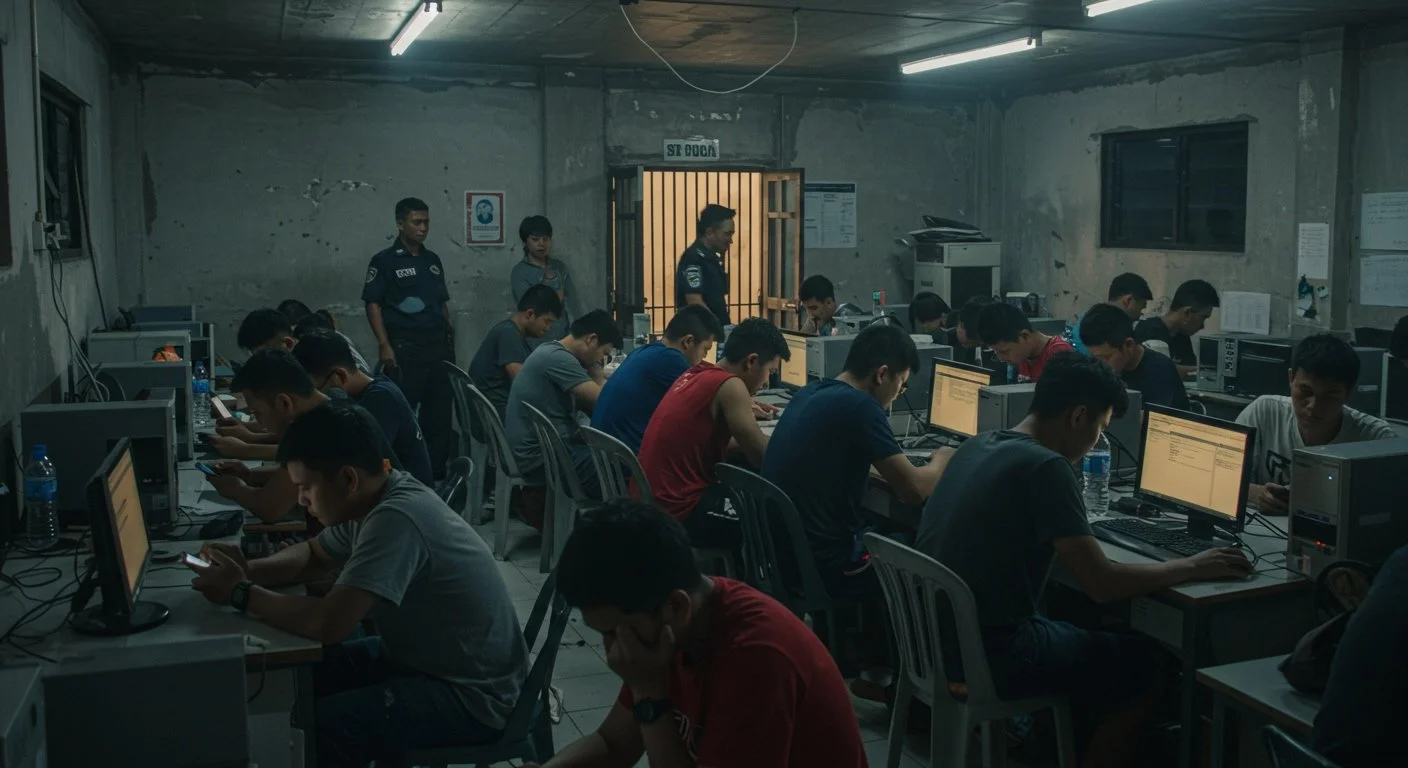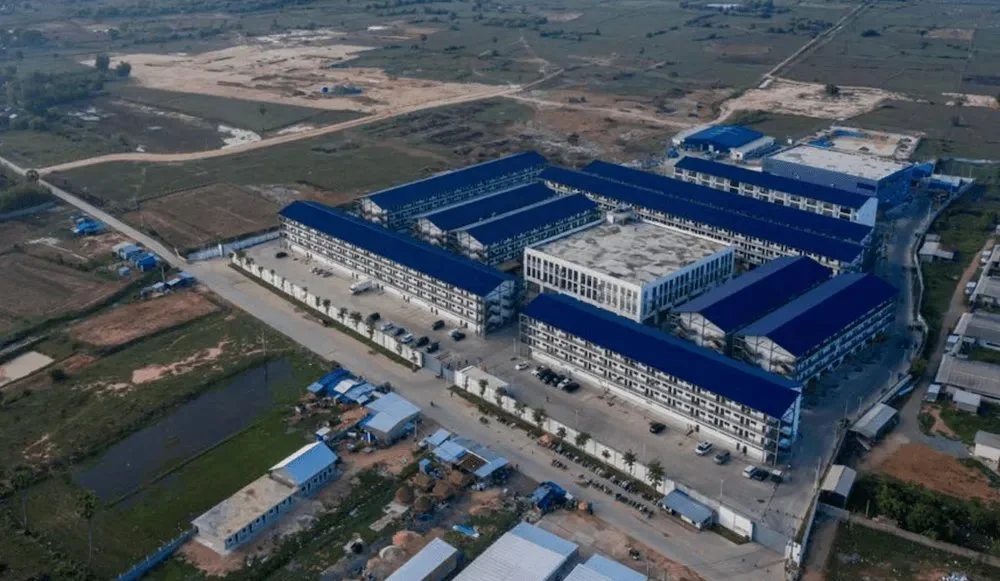Modern Slavery Behind the Screens
How Scam Compounds Are Expanding — And Why Following the Money Saves Lives
When Abdus Salam boarded his first international flight out of Bangladesh, he thought he was stepping into his future — the one where a young graduate could finally earn enough to lift his family out of debt.
Instead, he was trafficked into a locked compound in Cambodia, forced to work endless shifts behind fake social media profiles, and beaten if he failed to trick strangers a continent away.
“I thought I was going to Cambodia to support my family. Instead, I was sold, forced to scam people, and watched my colleagues get tortured when they didn’t bring in enough money.”
— Abdus Salam, survivor Humanity Consultancy
His story is not unique. Abdus is one face behind what Interpol now calls a parallel pandemic: industrial-scale scam compounds that traffic people as forced scammers and steal billions from people they’ve never met. It’s modern slavery — powered by money trails that cross every border.
The Machine That Devours People at Both Ends
Scam compounds run like high-security factories. Barbed wire. Guards with batons. Hundreds of people, mostly young, lured by fake job ads, locked in dormitories, forced to scam.
Linh Ne was only 17 when she left Vietnam for what she thought was a simple admin job. Instead, she spent two years in Bavet’s underground economy of fake shopping platforms and romance scams. When she refused, she was starved. When she gave in, she was forced to lure in more victims.
In Myanmar, Faysal, a Bangladeshi teenager, was forced to pose as a lover on WhatsApp for 20 hours a day. If he fell short of his targets, he was shocked with electric wires.
“When a client says ‘I love you,’ then we start washing his brain how to get money. We are not scammers. We are victims.”
Every scam compounds produces two sets of victims. The first: the trafficked scammer. The second: the person on the other end who loses everything — savings, dignity, sometimes even their lives.
It’s Not Just Southeast Asia Anymore — Here’s Why
What started in the shadows of Cambodia’s casino towns and Myanmar’s border zones has spread fast — because it works. It’s cheap, mobile and devastatingly profitable.
Today, Interpol and UNODC warn that this crime model is evolving faster than any other modern organised crime trend. Industrial-scale cyber-enabled fraud is driven by sophisticated syndicates who mix forced labour, money laundering, wildlife smuggling and underground banking into one connected pipeline.
Scam bosses relocate to Special Economic Zones (SEZs) or territories beyond normal law — often controlled by non-state armed groups. Casinos, junkets, fake “tech parks” and travel agencies are the front. Behind them are cages, passports confiscated, armed guards outside the door.
Asian crime syndicates now dominate this business globally. They collaborate with other criminal networks, push billions in illicit funds, and hide their tracks through crypto, underground banking, and shell companies.
And they’re moving fast into new regions. Countries like Zambia, Namibia, and Nigeria are seeing new scam centres that mimic the same “compound” model. In the Pacific, syndicates are embedding in Fiji, Samoa, Tonga, Vanuatu — selling themselves as respectable investors in resorts or casinos, but covering forced labour, fraud and smuggling behind closed doors.
How big is it?
Southeast Asia alone lost up to US $37 billion to cyber fraud last year.
The US lost $5.6 billion to crypto scams — $4.4 billion traced to pig-butchering rackets born in these same compounds.
Cambodia’s scam economy now generates an estimated $12.5 billion a year — half the country’s GDP.
Even worse, the global ability to respond is shrinking. As WIRED reported, the collapse of USAID and other donor support has gutted rescue operations, shelters, and funding for undercover investigations.
AN IMAGE OF A CAMBODIAN SCAM COMPOUND. SOURCE: AMNESTY INTERNATIONAL
How Good Compliance Actually Saves Lives
It’s easy to think compliance is about paperwork. But at its best, it’s a rescue tool.
Picture this: a rural bank in West Africa sees a cluster of small wires from unrelated senders landing in a single student’s offshore wallet — just under the threshold that usually triggers questions. The KYC record shows no legitimate source of income. Instead of ignoring it, the compliance officer’s risk system flags the pattern as unusual. She files a Suspicious Transaction Report (STR) with her local Financial Intelligence Unit (FIU).
Investigators follow that single thread. The “student” is a mule for a forced scam ring. The crypto trail connects back to a known compound in Cambodia. That one STR gives law enforcement a way in — one lead to find both the stolen money and the people forced to run the scam.
This is why frontline staff matter. Every flagged transaction is a clue. Every suspicious wire is a chance to break the chain.
Why Anqa Exists
Abdus Salam escaped his compound — he works today to help rescue others. Linh Ne survived and speaks up for the trafficked women who don’t make it out. Faysal risked his life to say the simple truth: “We are victims.”
At Anqa, we exist because good compliance shouldn’t be a privilege for giant banks. We build practical, affordable tools that help small financial institutions — rural co-ops, remittance agents, local banks — see the hidden signs and do something about them.
Our KYC hub works for imperfect documents, not just perfect scenarios.
Our risk tools help spot behaviour patterns and “nature and purpose” inconsistencies — the small gaps forced scam money loves to slip through.
Our sanctions and watchlist screening includes known human traffickers and scam facilitators.
Our training is free, because the front line shouldn’t be the weakest link.
Behind Every Wire, A Human Story
Modern slavery is no longer just a distant headline. It’s happening behind your next suspicious wire, your next crypto deposit, your next flagged transaction.
Good compliance means that wire gets paused. That suspicious flow gets flagged. That victim — the one forced to run the scam and the one tricked out of their savings — gets a chance for someone to find them.
This is what “follow the money” means. This is why we do what we do.
If you’re ready to make your compliance real — not just policy — we’re ready too.
Let’s break the chain, one flagged transaction at a time.
🎧 Listen to our RegTech Real Talk podcast The Love Factory: Inside the Global Expansion of Digital Slavery here:
Spotify I Apple Podcasts I Youtube
References


